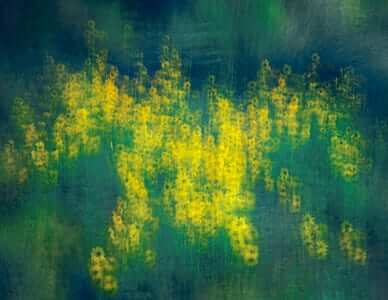When editing photographs, most photographers will often delete the soft or blurry photos. However, sometimes those images are the most intriguing. So, why not break the rules of sharp photos to achieve creativity like the impressionists did with their paintings? We spend time with Printique Ambassador, Jacki Dickert who shows us that by not staying inside the box, you can achieve personal satisfaction.
Most of the time, we photographers try to avoid blurry pictures carefully choosing shutter speeds to achieve sharpness holding our bodies still while we release the shutter to preserve detail. So why would we want to intentionally move our cameras in the midst of making exposures?
Besides being a fun and freeing experience, Intentional Camera Movement (ICM) can also satisfy our basic creative urges. We are able to do something different than “straight” photography in a way that can be even more personally expressive. In addition, much can be gained by experimenting with such a technique: a deeper understanding of how our cameras work, increased fluidity while shooting, and composition skills that become refined as we tune into and play with some of the basic elements that make up our images.
Springtime in the Swamp, ISO 100, f32, 1.3 sec
Obviously, when we practice intentional camera movement, we are creating something very different than detailed, documentary images. The results will naturally be more abstract and impressionist. Details are generally obscured, and what’s left after ICM is often an impressionistic wash of colors, with only the implication of basic shapes. However, the sense of movement that is inherently imbued in these images carries a sense of energy that can be very compelling.
Koi Pond, ISO 100, f25; 1 sec.
The basic technique for ICM involves choosing longer shutter speeds that will allow you to move the camera without overexposing your picture. Depending on the ambient light and focal length, somewhere between 1/8 of a second and 2 seconds is a good place to start experimenting. Since these long exposures will let in a great deal of light, you will have to compensate in one or more ways: lower your ISO, increase your f-stop, or add a polarizer or ND filter. I’ve even used sunglasses in a pinch, on my point and shoot camera! (You can also just wait until it gets darker out!)
Camera movements can vary, though it is generally effective to move in the direction of your main subject, and in the same plane. Vertical movements work well for tree trunks and plant stalks, horizontal sweeps are pleasing for beach scenes, and circular movements can be magical for flowers.
Sumac Stalks in Early Autumn, ISO 100, f32, 1 sec.
To preserve some of the graphic elements in the scene, movements are smaller than one might expect, several centimeters at most. Motions can be either in one direction or back and forth once or several times, depending on the length of the shutter speed and the desired effect. Some ICM artists like to work on a tripod for consistency while others prefer handheld for its fluidity.
When choosing your composition and framing, including some strong or definite shapes will anchor your image and keep it from becoming a complete abstraction. Abstractions can be wonderful, though…so it’s really a matter of personal preference.
Twilight at the Beach, ISO 100, f22, 2 sec.
Tree trunks are fairly easy to use as subjects when starting with ICM. With just a slight up and down motion, you can make the trunks seem like they were made with brushstrokes. Look for good separation between the trunks for cleaner lines and forms.
Aspens, ISO 50, f27, 1/3sec
Color and lighting play an important role. Having your main subject contrast from the background – by color, for example – will allow the forms to take center stage in your composition.
Yellow on Green, ISO 100, f5.6, 2 sec.
When considering lighting, be careful of bright spots that might blow out during the long exposures. Flat light is often easier to deal with…but depending on the capabilities of your sensor, contrasting lighting can be dynamic and attractive. I particularly like sidelight when making blurs of tree trunks, as it helps accentuate the shapes.
Sidelit Trees, Impressionist
These suggestions are really just starting points for experimenting with ICM. Don’t be afraid to experiment. There are many ways of working with camera motion – pan blurs, zoom blurs, camera toss techniques, to name a few. An expanded world of creative expression is open to us when we use our cameras like this to “paint” with light, form, and color.
Thank you Jacki. Jacki uses Printique
metal prints to showcase her artwork.
“I am especially enamored of their metal prints. With fabulous color, detail, and pop, they make my photos stand out in the crowd. I can always trust Printique to do a great job!” – Jacki Dickert
To view more of Jacki’s artwork, click
HERE.
 >
>